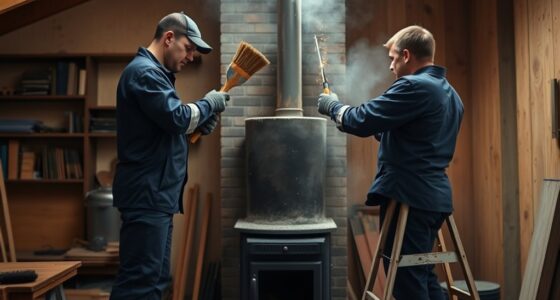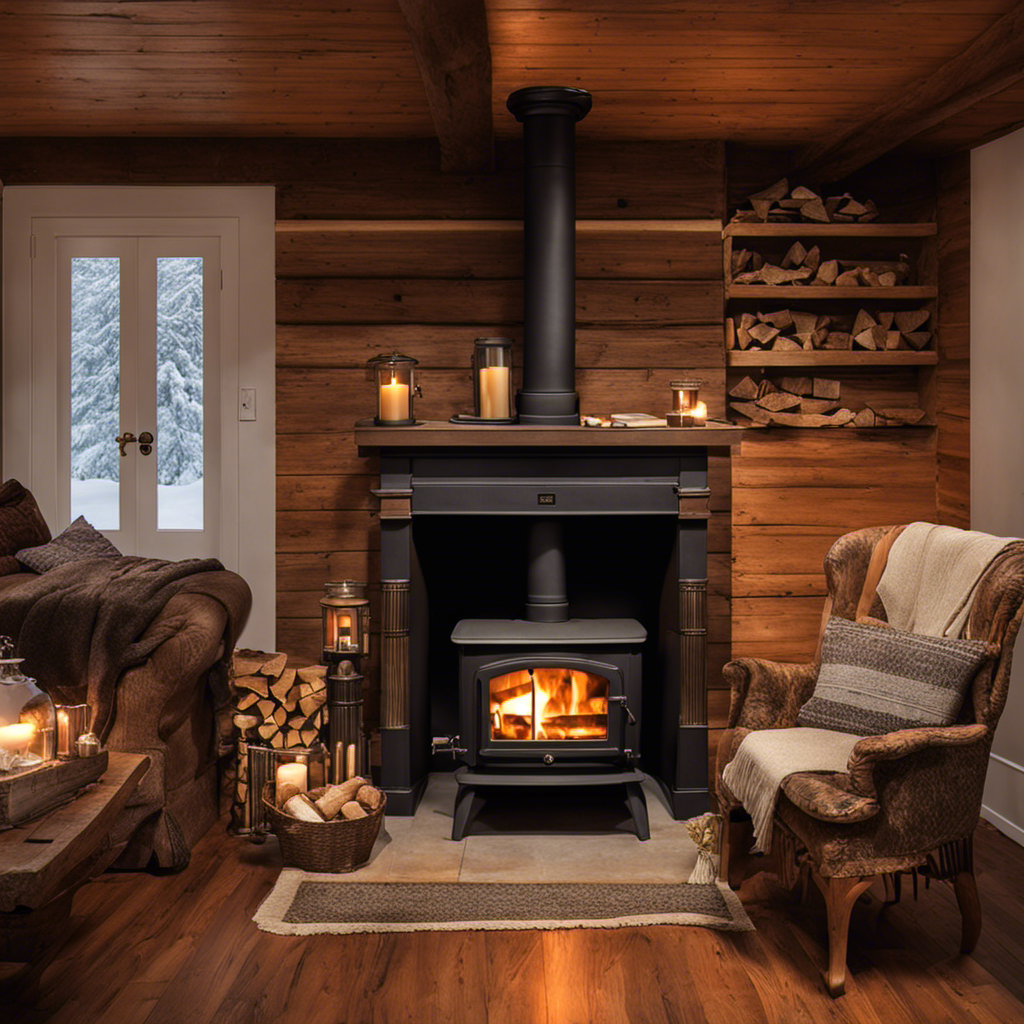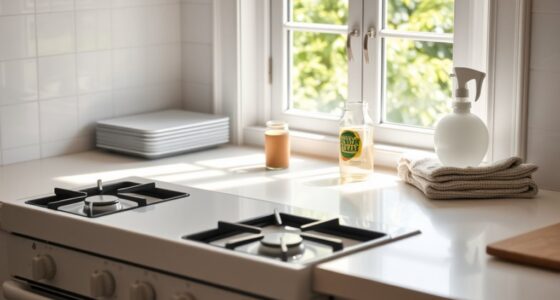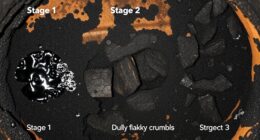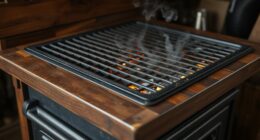To replace baffle plates and firebricks, start by inspecting your stove or fireplace for damage like cracks or chips. Carefully remove the old parts, noting their position, and clean the area of debris. Install the new baffle or bricks securely, ensuring they fit snugly without forcing. Always wear gloves and follow the manufacturer’s instructions for safety and proper placement. Keep exploring for detailed tips on ensuring your unit operates safely and efficiently.
Key Takeaways
- Regularly inspect baffle plates and firebricks for cracks, chips, or deterioration to ensure safe operation.
- Carefully remove damaged components, noting original placement, and clean the area before installing replacements.
- Install new baffle plates in the same orientation, ensuring a snug fit without interfering with door closure or venting.
- Replace broken firebricks by aligning them flush with surrounding bricks, using spacers if specified, and avoiding forced fitting.
- Always wear gloves and follow manufacturer instructions to ensure safe handling and proper installation of replacement parts.

Replacing baffle plates and firebricks is essential for maintaining your fireplace or stove’s efficiency and safety. When these components become cracked, warped, or worn out, they can compromise the combustion process and increase the risk of damage or safety hazards. Knowing proper installation tips and following correct maintenance procedures ensures you keep your heating appliance functioning at its best and extend its lifespan.
Start by inspecting your baffle plates and firebricks regularly; look for cracks, chips, or signs of deterioration. Once you’ve identified the need for replacement, gather the necessary tools—such as gloves, a pry bar, a screwdriver, and replacement parts compatible with your unit. Before beginning any work, disconnect the power or ensure the appliance is cool to avoid burns or other injuries. It’s also wise to review your manufacturer’s instructions, as installation tips can vary depending on your specific model.
Regularly inspect your baffle plates and firebricks for damage before safely replacing them.
When replacing baffle plates, carefully remove the old one by loosening brackets or screws holding it in place. Take note of how it sits within the stove or fireplace, as proper positioning is critical for airflow and combustion efficiency. Place the new baffle in the same orientation, ensuring it fits snugly without forcing it into position. Secure it firmly with the brackets or screws, making sure it’s stable. Proper installation tips emphasize checking that the baffle does not interfere with the door closure or venting pathways, as improper fit can hinder performance or cause smoke to escape. Additionally, ensuring correct alignment can improve overall efficiency and reduce emissions for better environmental impact.
Replacing firebricks follows a similar process. Remove any broken or cracked bricks, being cautious not to damage the surrounding bricks or the frame. Clean the area thoroughly to remove ash and debris, which can interfere with proper seating of the new bricks. When installing new firebricks, align them so they sit flush against adjacent bricks and the stove’s interior surfaces. Some models may require specific spacers or supports—consult your maintenance procedures to confirm. Ensuring each brick is securely in place but avoid forcing them, as misalignment can cause gaps or uneven burning. Regularly inspecting and replacing these bricks also helps prevent fire hazards caused by cracks or deterioration. Checking the manufacturer’s guidelines can provide additional tips for specific models.
Throughout this process, always prioritize safety. Wear gloves and eye protection, and handle bricks carefully to prevent chips or cuts. Regular maintenance procedures, like cleaning ash buildup and checking for damage, help you catch problems early. Additionally, using pimple patches can be a helpful addition to your skincare routine to treat breakouts around the house, ensuring your skin stays healthy while you focus on home maintenance. By following these installation tips and adhering to routine maintenance, you keep your appliance operating efficiently, reduce the risk of fire hazards, and prolong its service life. Proper replacement of baffle plates and firebricks isn’t just about immediate repairs; it’s about maintaining a safe, effective heating environment for years to come.
Frequently Asked Questions
How Often Should Baffle Plates and Firebricks Be Inspected?
You should inspect baffle plates and firebricks at least once every 50 to 100 hours of operation or monthly, whichever comes first. Incorporate this into your maintenance schedule to catch any wear or damage early. Regular inspections help prevent larger issues, guarantee efficient performance, and extend the lifespan of your equipment. Don’t ignore signs of deterioration, and always follow the manufacturer’s recommended inspection frequency for maximum results.
Can Damaged Firebricks Affect Stove Efficiency?
A chain is only as strong as its weakest link, and damaged firebricks can definitely hurt your stove’s efficiency. When firebrick deterioration occurs, heat escapes, and combustion becomes less effective. Regular baffle maintenance helps prevent this, but if firebricks are cracked or crumbling, your stove burns less efficiently, wastes fuel, and may even cause further damage. Keep an eye on them to guarantee ideal operation and safety.
Are Replacement Parts Compatible With All Stove Models?
Replacement parts are not universally compatible with all stove models. You need to check if they are model-specific or offer universal compatibility. Always verify the part number or consult the manufacturer to guarantee a proper fit. Using model-specific parts guarantees excellent performance, safety, and efficiency. Avoid generic options if your stove requires precise replacements, as incompatible parts can cause damage or reduce your stove’s effectiveness.
What Safety Precautions Are Necessary During Replacement?
You should definitely wear protective gear, like gloves and safety glasses, to prevent burns and debris injuries. Also, confirm proper ventilation precautions by working in a well-ventilated area or using fans, as fumes and dust can be harmful. It’s wise to verify that the stove is cool before starting, and always follow manufacturer instructions. Taking these safety steps helps prevent accidents and keeps you safe during the replacement process.
How Long Does It Typically Take to Replace Baffle Plates?
Replacing baffle plates typically takes about 4 to 8 hours, depending on your experience and equipment. The installation timeline can vary, so plan accordingly. You should also consider the replacement cost, which includes parts and labor, usually ranging from a few hundred to over a thousand dollars. Proper preparation and safety measures can help guarantee the process goes smoothly, minimizing delays and additional expenses.
Conclusion
Replacing baffle plates and firebricks is like giving your stove a fresh start—you’re restoring its strength and efficiency. Keep up with regular maintenance, and your fireplace will burn brighter and last longer. Just as a well-tuned engine runs smoothly, a properly cared-for stove provides warmth and safety. Don’t wait for issues to pile up; proactive repairs are the key to keeping your fire burning strong, like a steady heartbeat fueling warmth in your home.




